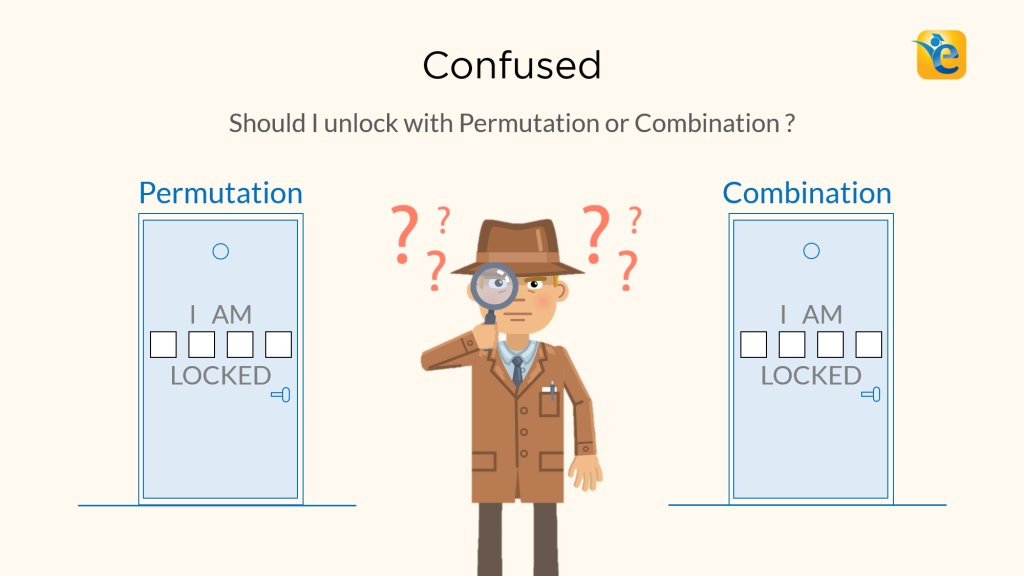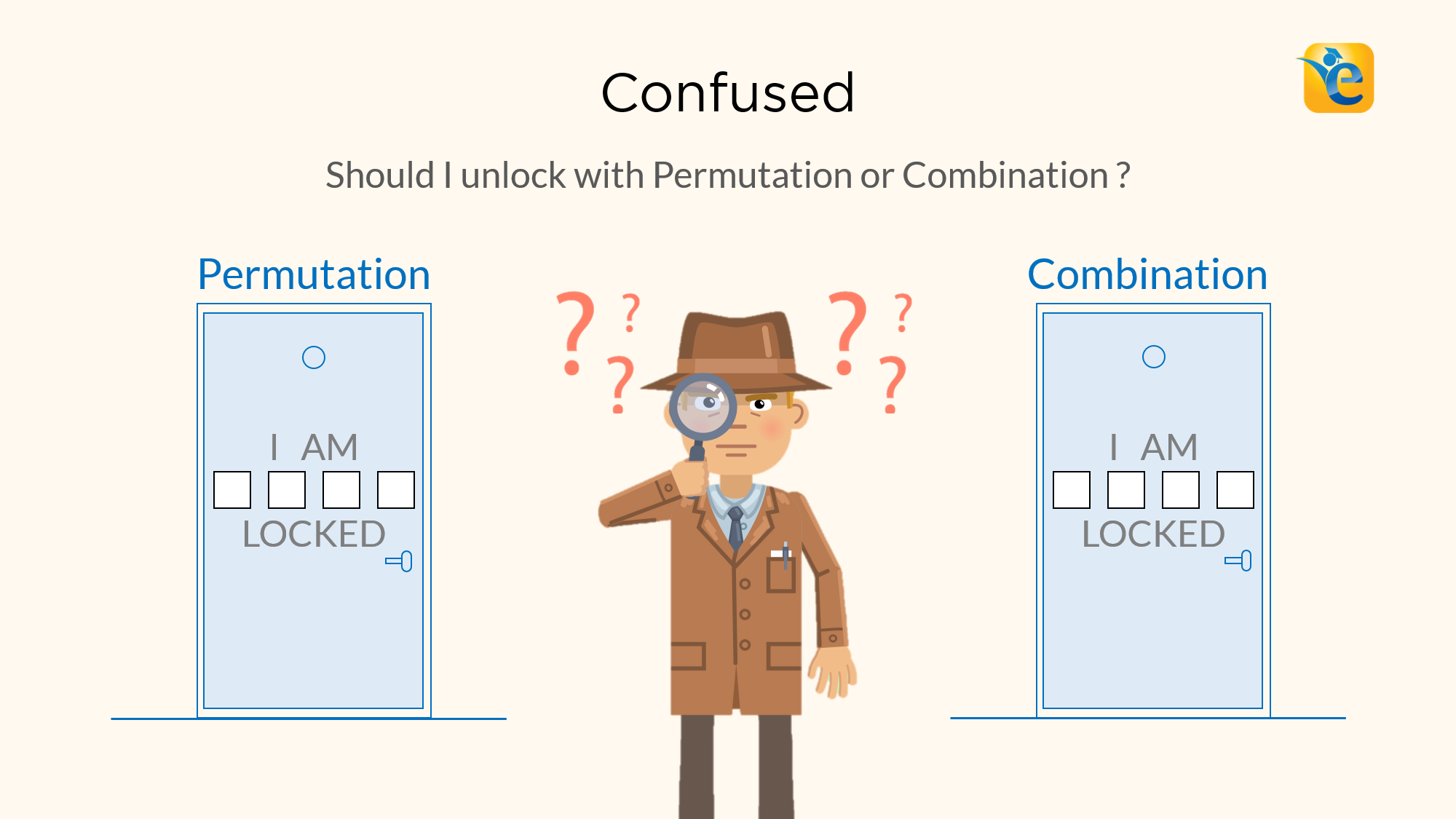Ask any GMAT test-taker about counting methods, and you’ll likely hear a collective groan about permutations and combinations. These concepts consistently rank among the most confusing topics on the quantitative section—not because they’re inherently difficult, but because they appear so frustratingly similar at first glance.
The good news? The key to mastering permutation vs combination problems lies in understanding one fundamental distinction: Does order matter?
This comprehensive guide will demystify the key differences between permutations and combinations, show you exactly how to identify which concept to apply, and help you avoid the most common mistakes that trip up GMAT candidates.
Key Takeaways: When to Use Permutation and Combination
- The key to GMAT counting problems is determining whether order matters: use permutations when arrangement matters and combinations when only selection matters.
- Identify problem types through keywords: “arrange,” “order,” “rank” signal permutations; “select,” “committee,” “group” typically indicate combinations without specifying roles.
- Break complex problems into components by determining whether order matters for each part, then multiply the results using the fundamental counting principle.
- Before selecting a formula, always ask: “Would rearranging the same selection create a different outcome?” This single check prevents most GMAT counting errors.
- Permutation values are exactly r! times larger than combination values (P(n,r) = C(n,r) × r!), explaining why many GMAT trap answers are off by this factor.
In the last article of ‘Permutation and Combination’ series we talked about ‘when to ADD and MULTIPLY’? If you haven’t read the article here is the link: GMAT Permutation and Combination | When to Add and Multiply

With the basic understanding of AND – OR keywords, let us dive into the advanced concept of the difference between permutation and combination.
- Understanding Permutation vs Combination: The Fundamental Difference
- Understanding Factorial Notation: The Foundation of Both Formulas
- Mastering the Permutation Formula
- Mastering the Combination Formula
- Formula Memorization Strategies: Making It Stick
- GMAT in Action: Mastering Permutations vs Combinations Through Real Examples
- Common Mistakes: Pitfalls to Avoid on Permutation and Combination Questions
- Practice Makes Perfect: GMAT-Style Problems with Step-by-Step Solutions
- Conclusion: Mastering the Distinction Between Permutation and Combination
- FAQs
Are you struggling with GMAT quant? e-GMAT provides structured learning from foundations to help you master the skills needed for a high score. Join the world’s most successful prep company for a free trial and see the difference it can make. We are the most reviewed online GMAT Prep company with 2500+ reviews on GMATClub, as of March 2023.
Understanding Permutation vs Combination: The Fundamental Difference
Permutations and combinations represent two fundamental counting principles in mathematics that frequently appear on the GMAT. While both concepts involve selecting items from a group, they differ in one critical aspect that determines which formula to use when solving problems.
Understanding this core difference between permutation vs combination is essential for GMAT success. Many test-takers lose points by applying the wrong concept, often because they fail to recognize whether order matters in a given scenario.
The One Crucial Question: Does Order Matter?
When tackling a GMAT problem involving selecting or arranging items, the essential question to ask yourself is: “Does the order of selection matter?” This single question will guide you to the correct approach.
Permutations: Arrangements where order matters
- A permutation is a specific ordering or arrangement of objects
- Formula: P(n,r) = n!/(n-r)! where n is the total number of items and r is how many you’re arranging
- Example calculation: Arranging 3 books from a shelf of 8 books: P(8,3) = 8!/(8-3)! = 8!/5! = 336 different arrangements
Combinations: Selections where order doesn’t matter
- A combination is simply a grouping or selection of objects without regard to order
- Formula: C(n,r) = n!/[r!(n-r)!] where n is the total number of items and r is how many you’re selecting
- Example calculation: Selecting 3 books from a shelf of 8 books: C(8,3) = 8!/[3!(8-3)!] = 8!/[3!5!] = 56 different combinations
Real-World Scenarios: Permutation vs Combination in Action
Scenario 1: Committee Selection (Combination) vs. Race Rankings (Permutation).
Committee Selection: When forming a 3-person finance committee from 10 employees, only membership matters. Selecting Alice, Bob, and Charlie creates the same committee as selecting Charlie, Alice, and Bob.
Race Rankings: When determining 1st, 2nd, and 3rd place in a 10-person race, order is crucial. Alice finishing 1st, Bob 2nd, and Charlie 3rd represents a different outcome than Charlie 1st, Alice 2nd, and Bob 3rd.
Scenario 2: Pizza Toppings (Combination) vs. Password Creation (Permutation)
Pizza Toppings: When selecting 3 toppings from 8 options for your pizza, the order of selection doesn’t affect the final pizza. Choosing pepperoni, mushrooms, and olives creates the same pizza as choosing olives, pepperoni, and mushrooms.
Password Creation: When creating a 3-character password from 8 possible characters, the sequence matters significantly. The password “ABC” is entirely different from “CBA,” even though they use the same characters.
Scenario 3: Lottery Numbers (Combination) vs. Phone Numbers (Permutation)
Lottery Numbers: In a lottery where you select 6 numbers from 49 possibilities, the order of selection doesn’t matter. Drawing 7-12-23-34-42-48 is the same winning combination as 48-42-34-23-12-7.
Phone Numbers: A 7-digit phone number represents a specific sequence of digits. The number 765-4321 connects to a different person than 123-4567, even though they use the same digits.
Why Order Matters on the GMAT
How this distinction affects calculation approaches:
- Using the incorrect formula leads to answers that differ by a factor of r! (factorial of r)
- For small values of r, this might be a 2x or 6x difference, but for larger values, this can result in answers that are hundreds or thousands of times different
- The GMAT often includes trap answer choices that correspond to using the wrong approach
Example: From 10 finalists, how many ways can we arrange the top 4 winners?
- Permutation (correct): P(10,4) = 10!/(10-4)! = 10!/6! = 5,040 different arrangements
- Combination (incorrect): C(10,4) = 10!/[4!(10-4)!] = 10!/[4!6!] = 210 different combinations
Decision Framework for Permutation and Combination
When approaching GMAT problems, apply this simple decision framework to determine whether to use permutation or combination:
Identify the core action:
- Are you arranging objects in positions? → Permutation
- Are you simply selecting objects? → Combination
Look for these keywords and contexts:
- Permutation keywords: arrange, order, sequence, schedule, rank, list, lineup
- Combination keywords: select, choose, pick, group, committee, team, subset
Ask the critical question: “If I rearrange the same items, is the outcome different?”
- If YES → Permutation
- If NO → Combination
Permutations are about arrangement (order matters), while combinations are about selection (order doesn’t matter).
This fundamental distinction is the key to correctly identifying and solving permutation and combination problems on the GMAT. By training yourself to immediately identify whether order matters in a given problem, you’ll significantly improve your accuracy and speed on these commonly tested concepts.
Begin your GMAT preparation with the only prep company that has delivered more than 700+ scores than any other GMAT club partner. Achieve GMAT 740+ with our AI-driven tools that you personalized feedback at every step of your GMAT journey. Take our free trial today!
Understanding Factorial Notation: The Foundation of Both Formulas
Before we can tackle permutations and combinations, we need to understand the foundation both formulas are built on: factorials.
A factorial is represented by an exclamation mark (!) and means multiplying a number by all positive integers less than it.
For example:
- 4! = 4 × 3 × 2 × 1 = 24
- 3! = 3 × 2 × 1 = 6
- 2! = 2 × 1 = 2
- 1! = 1
- 0! = 1 (by mathematical convention)
Real-World Examples of Factorial
Let’s make factorials more concrete with everyday scenarios:
- Restaurant Menu Combinations: If a restaurant offers 4 appetizers, 6 main courses, and 5 desserts, the number of possible three-course meals is 4 × 6 × 5 = 120. This is a classic example of multiplication principle.
- Arranging Books on a Shelf: With 5 distinct books, there are 5! = 120 different possible arrangements on your bookshelf.
- Team Captain Selection: If your company’s softball team needs to select a captain, vice-captain, and secretary from 10 players, this involves selecting and arranging 3 people from 10, which requires factorials.
Mastering the Permutation Formula
Permutations come into play when you need to select AND arrange items in a specific order.
The permutation formula for selecting and arranging r objects from n distinct objects is:
P(n,r) = n!/(n-r)!
Step-by-Step Derivation Through Counting Principles
Let’s understand why this permutation formula works:
- When selecting and arranging r items from n items, for the first position, you have n choices.
- For the second position, you have (n-1) choices remaining.
- For the third position, you have (n-2) choices remaining.
- This pattern continues until you’ve filled all r positions.
Using the multiplication principle of counting: P(n,r) = n × (n-1) × (n-2) × … × (n-r+1)
This expression equals: P(n,r) = n!/(n-r)!
Why We Use n!/(n-r)!
Think of it this way: The full factorial n! gives us the number of ways to arrange all n items. However, since we’re only arranging r of them, we need to “cancel out” the arrangements of the remaining (n-r) items. That’s why we divide by (n-r)!
Worked Example: Arranging 3 Books from 7 Options
Scenario: How many ways can we select and arrange 3 books from 7 books on a display stand?
Solution using permutation formula: 7P3 = 7!/(7-3)! = 7!/4! = (7 × 6 × 5 × 4!)/(4!) = 7 × 6 × 5 = 210
There are 210 different ways to select and arrange 3 books from 7 books.
Verification through counting principles:
- First position: 7 choices
- Second position: 6 choices
- Third position: 5 choices
- Total: 7 × 6 × 5 = 210
Mastering the Combination Formula
Combinations involve selecting objects without regard to order. The formula for selecting r objects from n distinct objects is:
C(n,r) = n!/[(n-r)! × r!]
Building from the Permutation Formula
The combination formula is closely related to the permutation formula:
- Start with the permutation formula: P(n,r) = n!/(n-r)!
- In a combination, the order doesn’t matter. For each set of r objects selected, there are r! different ways to arrange them.
- Since all these arrangements count as just one combination, we divide P(n,r) by r!
- This gives us the combination formula: C(n,r) = P(n,r)/r! = n!/[(n-r)! × r!]
Why We Divide by r! – Connecting to the “Order Doesn’t Matter” Concept
The key distinction:
- In permutations, selecting books A, B, C is different from selecting books A, C, B because the order matters.
- In combinations, selecting books A, B, C is the same as selecting books A, C, B because we only care about which books were selected, not their order.
For any set of r items, there are r! different ways to arrange them. By dividing the number of permutations by r!, we account for this and eliminate the redundant counting.
Same Example (3 Books from 7) with Different Approach and Result
Scenario: How many ways can we select 3 books from 7 books for a reading list?
Solution using combination formula: 7C3 = 7!/[(7-3)! × 3!] = 7!/[4! × 3!] = (7 × 6 × 5 × 4!)/(4! × 3 × 2 × 1) = (7 × 6 × 5)/(3 × 2 × 1) = 210/6 = 35
There are 35 different ways to select 3 books from 7 books when order doesn’t matter.
Comparison with permutation:
- Permutation (7P3 = 210): For a display stand where the order of books matters
- Combination (7C3 = 35): For a reading list where only the selection of books matters, not their order
Take a free GMAT mock to understand your baseline score and start your GMAT prep with our free trial. We are the most reviewed online GMAT Prep company with 2500+ reviews on GMATClub
Formula Memorization Strategies: Making It Stick
Now that you understand the logic behind these formulas, let’s make sure you can recall them quickly on test day.
Mnemonic Devices
Simple memory aids can help you quickly recall which formula to use:
- “P for Position” – In permutations, the position or order matters (like arranging people in a line)
- “C for Collection” – In combinations, we’re just collecting items without concern for order (like selecting team members)
- “Divide by r! when order doesn’t matter” – The key difference between permutations and combinations
Key Takeaways
Let’s summarize the key takeaways from this section:
- Factorial (n!) is the product of all integers from n down to 1
- Permutation (nPr = n!/(n-r)!) is used when order matters
- Combination (nCr = n!/[(n-r)! × r!]) is used when order doesn’t matter
- The key difference: combinations divide permutations by r! to account for the “order doesn’t matter” principle
- Use mnemonics like “P for Position” and “C for Collection” to remember which is which
Remember, mastering these formulas isn’t just about memorization—it’s about understanding when and why to apply them. With practice, you’ll quickly recognize which formula a problem requires based on whether the order of selection matters.
Scoring a Q50-51 on the GMAT helps you get a 700+ GMAT score. Start your journey of getting a Q50-51 on the GMAT with e-GMAT’s AI-driven online preparation course. Our xPERT not only curates the most optimized learning path but also tracks your improvement, ensuring that you get to your target Quant score quickly and reliably. Watch this video to know more:
GMAT in Action: Mastering Permutations vs Combinations Through Real Examples
Understanding when to use combinations versus permutations often represents the difference between getting a question right or wrong on test day. Let’s explore paired examples that highlight the key differences between these concepts, progressing from basic to more complex GMAT-style scenarios.
Basic Example Pair: Committee Formation vs. Prize Distribution
Combination Example: Forming a 3-person committee from 8 candidates
Combination Problem: A student organization with 8 members needs to form a 3-person committee. How many different committee compositions are possible?
Solution:
- This is a combination problem because the order of selection doesn’t matter – committee members have equal roles
- We’re selecting 3 people from 8 candidates where only WHO is on the committee matters
- Formula: C(n,r) = n!/(r!(n-r)!) where n = total items, r = items selected
- C(8,3) = 8!/(3!(8-3)!) = 8!/(3!5!) = (8×7×6)/(3×2×1) = 336/6 = 56
- There are 56 possible committee compositions
Permutation Example: Awarding first, second, and third prizes among 8 candidates
Problem: In a contest with 8 participants, judges need to award a first, second, and third prize. How many different prize distributions are possible?
Solution:
- This is a permutation problem because the order matters – each position (1st, 2nd, 3rd) is different
- We’re selecting 3 people from 8 candidates where WHO gets WHICH prize matters
- Formula: P(n,r) = n!/(n-r)! where n = total items, r = items selected
- P(8,3) = 8!/(8-3)! = 8!/5! = 8×7×6 = 336
- There are 336 possible prize distributions
Key Difference: With the same 8 people and selecting 3, we get 56 combinations (order doesn’t matter) versus 336 permutations (order matters). The permutation value is exactly 6 times larger because there are 3! = 6 ways to arrange each selected group of 3 people.
Linguistic Cues:
- Combination signal: “committee,” “team,” “group” (roles not distinguished)
- Permutation signal: “prizes,” “ranks,” “positions” (distinct roles)
Quick Decision Rule:
Ask yourself: “If I rearrange the selected items, do I get the same outcome?” If yes, use combinations. If no, use permutations.
Medium Complexity Example Pair: Project Selection vs. Project Prioritization
Combination Example: Selecting 4 projects from 10 initiatives for funding
Problem: A foundation has received proposals for 10 community initiatives but can only fund 4 of them. How many different ways can they select 4 projects to fund?
Solution:
- This is a combination problem because we’re simply selecting which projects get funded, not ranking them
- The order doesn’t matter – each selected project gets funding regardless of selection order
- C(10,4) = 10!/(4!(10-4)!) = 10!/(4!6!)
- C(10,4) = (10×9×8×7)/(4×3×2×1) = 5040/24 = 210
- There are 210 possible funding combinations
Permutation Example: Prioritizing 4 projects from 10 initiatives by importance
Problem: A foundation has 10 community initiatives and needs to select 4 to highlight in their annual report, ranked from most to least impactful. How many different ways can they create this ranked list?
Solution:
- This is a permutation problem because we’re selecting AND ordering the projects
- The order matters – being ranked 1st is different from being ranked 4th
- P(10,4) = 10!/(10-4)! = 10!/6!
- P(10,4) = 10×9×8×7 = 5040
- There are 5040 possible ways to create the ranked list
Key Difference: The use of words like “prioritizing”, “ranking” signals that order matters, making this a permutation problem. The number of permutations (5040) is exactly 24 times larger than the number of combinations (210) because there are 4! = 24 ways to arrange each selected group of 4 projects.
Linguistic Cues:
- Combination signal: “select for funding” (equal treatment)
- Permutation signal: “prioritize,” “rank,” “highlight in order” (sequential arrangement)
Quick Decision Rule: When you see words suggesting hierarchical arrangement or sequence, prepare to use permutations.
Test Your Understanding
Question: A restaurant chef wants to create a special 3-course meal by selecting 3 dishes from a list of 8 signature recipes. How many different 3-course meals are possible
Answer: This is a permutation problem since the order matters (appetizer, main course, dessert). P(8,3) = 8!/(8-3)! = 8!/5! = 8×7×6 = 336 different meal sequences.
Read the next article on ‘3 deadly mistakes you must avoid in Permutation and Combination‘
GMAT-Style Word Problem Pair: Tech Feature Implementation
Combination Example: Tech company selecting 3 of 7 features for product release
Problem: TechStart plans to add 3 new features to their app from a list of 7 possible features. Each feature requires the same development time. How many different combinations of features could they include in this update?
Solution:
- This is a combination problem because only the selection matters, not the order of implementation
- Linguistic cue: no mention of sequence or priority suggests combinations
- C(7,3) = 7!/(3!(7-3)!) = 7!/(3!4!) = (7×6×5)/(3×2×1) = 210/6 = 35
- There are 35 possible feature combinations
Permutation Example: Tech company implementing 3 of 7 features in sequential monthly updates
Problem: TechStart plans to implement 3 new features from a list of 7 possible features. They will release one feature per month over the next three months. How many different implementation schedules are possible?
Solution:
- This is a permutation problem because both the selection AND sequence matter
- Linguistic cues: “sequential monthly updates” and “release one feature per month” indicate order matters
- P(7,3) = 7!/(7-3)! = 7!/4! = 7×6×5 = 210
- There are 210 possible implementation schedules
Key Difference: The combination problem focuses on WHICH features to include, while the permutation problem requires deciding WHICH features AND IN WHAT ORDER to implement them. The subtle change in wording completely changes the mathematical approach.
Linguistic Cues:
- Combination signal: Focus only on selection with no mention of order or sequence
- Permutation signal: Words like “sequential”, “monthly updates”, “release one per month”
GMAT Insight: These nearly identical problems test your ability to distinguish subtle linguistic differences that signal different mathematical approaches—a common GMAT testing strategy.
Test Your Understanding
Question: A student must answer 5 questions out of 8 on an exam. How many different ways can the student select the questions to answer?
Answer: This is a combination problem since the order of answering doesn’t affect scoring. C(8,5) = 8!/(5!3!) = 56 different ways to select questions.
Common Mistakes: Pitfalls to Avoid on Permutation and Combination Questions
The difference between permutations and combinations is a foundational concept that frequently appears on the GMAT. However, this area is also rife with opportunities for error, especially if you’re still developing your understanding of these concepts.
Most mistakes fall into two main categories:
- Conceptual misidentification errors – using the wrong approach entirely
- Formula application errors – applying the right concept incorrectly
Conceptual Misidentification Errors
Using Permutation When Combination is Required
This is perhaps the most common mistake in permutation and combination problems. Students often default to using permutations (nPr) when they should be using combinations (nCr) because they fail to analyze whether order matters in the specific problem context.
Root cause: Misunderstanding the fundamental difference between when order matters and when it doesn’t. You might be misled by problem wording or may not thoroughly analyze what the problem is asking.
Using Combination When Permutation is Required
The inverse error is also common: using combinations when the problem requires attention to order or arrangement.
Root cause: Failing to recognize when order/arrangement is significant to the problem.
Example problem: In how many different ways can 5 runners finish in a race (assuming no ties)?
- Incorrect approach: Using combination: 5C5 = 1
- Why it’s wrong: The finishing order absolutely matters in a race – the order (1st, 2nd, 3rd, 4th, 5th) creates different outcomes.
- Correct approach: Using permutation: 5P5 = 5! = 120
- Why it’s right: Since we’re arranging 5 runners in 5 distinct positions, and the order matters, a permutation is appropriate.
Formula Application Errors
Even when you correctly identify whether to use permutation or combination, errors can still occur in the calculation process.
Factorial Calculation Mistakes
Common factorial calculation errors include:
- Misunderstanding factorial definition:
- Incorrect: 4! = 4 × 4 × 4 × 4 = 256
- Correct: 4! = 4 × 3 × 2 × 1 = 24
- Forgetting that 0! = 1: This special case trips up many students, but it’s a crucial definition to remember.
- Order of operations errors:
- Incorrect: 7!/(4!*3!) calculated as (7!/4!) × 3! = 210 × 6 = 1,260
- Correct: 7!/(4!3!) = 5,040/(24×6) = 5,040/144 = 35
- Calculator usage errors:
- Not using parentheses properly
- Not understanding the factorial function on calculators
- Truncation or overflow errors with large factorials
Preventative Strategies
To avoid these common errors, follow these simple but effective strategies:
- Always verify whether order matters before choosing a formula:
- If order matters → Permutation
- If order doesn’t matter → Combination
- Double-check your parameter values:
- Clearly identify what constitutes your total pool (n)
- Clearly identify how many you’re selecting/arranging (r)
- Verify that n ≥ r
- Follow systematic problem-solving steps:
- Read the problem twice
- Identify exactly what’s being counted
- Determine if order matters
- Select the appropriate formula
- Substitute values correctly
- Calculate carefully
- Estimate your answer for reasonableness:
- If selecting 3 people from 10, your answer should be substantially less than 1,000 – if it’s significantly higher or lower, verify your calculation.
- For complex problems, break them down into smaller parts:
- For problems with multiple constraints, recognize component parts that require different approaches.
- When unsure, test with a small example first:
- If you’re uncertain about your approach, try a simplified version of the problem where you can count all possibilities manually, then extend the pattern.
Practice Makes Perfect: GMAT-Style Problems with Step-by-Step Solutions
Ready to test your understanding of permutation vs combination? Try solving these problems before checking the solutions. Each problem progressively increases in difficulty, helping you build confidence and develop strategic thinking skills essential for GMAT success.
Foundational Practice Problems
Problem 1: A manager needs to arrange 5 different books on a shelf. In how many different ways can the books be arranged?
Solution: This is a permutation problem since we need to arrange items in a specific order.
Using the permutation formula: P(n,r) = n!/(n-r)!
Here, n = 5 (total books) and r = 5 (all books being arranged) P(5,5) = 5!/(5-5)! = 5!/0! = 5!/1 = 5 × 4 × 3 × 2 × 1 = 120
Therefore, there are 120 different possible arrangements of the 5 books.
Key Insight: When arranging all available items in a specific order, the total number of permutations equals n! (n factorial). This problem illustrates a pure permutation scenario where order matters.
Problem 2: A team captain needs to select 3 players from a group of 8 players for a special training session. In how many different ways can the captain select the 3 players?
Solution: This is a combination problem since we only care about which players are selected, not the order of selection.
Using the combination formula: C(n,r) = n!/[r!(n-r)!]
Here, n = 8 (total players) and r = 3 (players being selected) C(8,3) = 8!/[3!(8-3)!] = 8!/[3!5!] = (8 × 7 × 6)/(3 × 2 × 1) = 336/6 = 56
Therefore, there are 56 different ways to select 3 players from the group of 8.
Key Insight: When selecting items without regard to order, we use combinations. The formula reduces the count significantly compared to permutations because it eliminates redundant arrangements of the same selections.
Problem 3: A company has 7 new employees. For a training program, the HR manager needs to: a) Arrange 4 of these employees in a line for a demonstration. b) Select 4 of these employees to attend a workshop. How many different possibilities exist for each scenario?
Solution: a) Arranging 4 employees in a line: This is a permutation problem because the order matters. P(7,4) = 7!/(7-4)! = 7!/3! = (7 × 6 × 5 × 4) = 840
b) Selecting 4 employees for a workshop: This is a combination problem because the order doesn’t matter. C(7,4) = 7!/[4!(7-4)!] = 7!/[4!3!] = (7 × 6 × 5 × 4)/(4 × 3 × 2 × 1) = 840/24 = 35
Key Insight: This problem directly contrasts permutation and combination. Notice that for the same values (7 choose 4), the permutation count (840) is much larger than the combination count (35) because permutations account for every possible order. Specifically, P(n,r) = C(n,r) × r! because each combination can be arranged in r! ways.
Intermediate Practice Problems
Problem 4: A student must answer 8 questions out of 12 on an exam. The questions are divided into two sections: questions 1-5 are calculus and questions 6-12 are algebra. The student must answer at least 3 calculus questions and at least 4 algebra questions. How many different ways can the student select the questions?
Solution: Since we’re selecting questions without regard to order, this is a combination problem with constraints.
We need to break this down into cases based on the number of calculus questions selected:
Total questions to be answered: 8 Calculus questions available: 5 Algebra questions available: 7 Constraints: At least 3 calculus and at least 4 algebra questions
Possible valid distributions:
Case 1: 3 calculus and 5 algebra questions
- Ways to select 3 calculus questions from 5: C(5,3) = 10
- Ways to select 5 algebra questions from 7: C(7,5) = 21
- Total for Case 1: 10 × 21 = 210
Case 2: 4 calculus and 4 algebra questions
- Ways to select 4 calculus questions from 5: C(5,4) = 5
- Ways to select 4 algebra questions from 7: C(7,4) = 35
- Total for Case 2: 5 × 35 = 175
Case 3: 5 calculus and 3 algebra questions
- This case is invalid because we need at least 4 algebra questions.
Total number of ways = 210 + 175 = 385
Common Wrong Approach: A common mistake is calculating C(12,8) = 495, which counts all ways to select 8 questions from 12 without respecting the section constraints. Another error is miscounting the number of algebra questions (there are 7, not 5), which leads to incorrect calculations.
Problem 5: In how many ways can 7 people be seated in a row if two specific people, Alice and Bob, must sit next to each other?
Solution: This problem involves permutation with constraints.
Step 1: Treat Alice and Bob as a single unit. This reduces the problem to arranging 6 entities (one combined “Alice-Bob” unit plus 5 other people). Number of ways to arrange 6 distinct entities: 6! = 720
Step 2: Alice and Bob can be arranged within their unit in 2! = 2 ways (Alice-Bob or Bob-Alice).
Step 3: Multiply to get the total: 720 × 2 = 1,440
Therefore, there are 1,440 different seating arrangements.
Common Wrong Approach: Some might calculate 7! = 5,040 (total permutations of 7 people) and then try to subtract “invalid” arrangements, which is more complex and error-prone. Another common mistake is forgetting to account for the internal arrangement of Alice and Bob (the 2! factor), yielding only 720 arrangements instead of 1,440.
Advanced Practice Problems
Problem 6: A company committee consists of 4 executives (E1, E2, E3, E4 in descending order of seniority) and 8 managers. A task force of 5 people needs to be formed from this committee. The task force must include at least 2 executives, and the most senior executive present must be the leader of the task force. In how many ways can the task force be formed?
Solution: This problem combines permutation and combination concepts with additional constraints.
First, let’s determine the possible compositions of the task force:
- 2 executives and 3 managers
- 3 executives and 2 managers
- 4 executives and 1 manager
For each case:
Case 1: 2 executives and 3 managers
- Ways to select 2 executives from 4: C(4,2) = 6
- For each executive selection, we need to identify the leader (most senior):
- If E1 is selected: E1 is leader. This happens in C(3,1) = 3 ways (selecting one more executive from E2, E3, E4)
- If E1 isn’t selected but E2 is: E2 is leader. This happens in C(2,1) = 2 ways (selecting one more executive from E3, E4)
- If only E3 and E4 are selected: E3 is leader. This happens in 1 way
- For each executive selection, we select 3 managers from 8: C(8,3) = 56
- Total for Case 1: 6 × 56 = 336
Case 2: 3 executives and 2 managers
- Ways to select 3 executives from 4: C(4,3) = 4
- For each executive selection, the leader is determined by the most senior executive present
- Ways to select 2 managers from 8: C(8,2) = 28
- Total for Case 2: 4 × 28 = 112
Case 3: 4 executives and 1 manager
- Only 1 way to select all 4 executives
- E1 is automatically the leader
- Ways to select 1 manager from 8: C(8,1) = 8
- Total for Case 3: 1 × 8 = 8
Total ways to form the task force = 336 + 112 + 8 = 456
Strategic Thinking Note: This problem demonstrates how to systematically break down a complex scenario with multiple constraints. The key insight is recognizing that the leadership aspect introduces an element of permutation within the combination problem. For GMAT problems like this, identifying constraints correctly is crucial for efficient problem-solving.
Problem 7: From a standard 52-card deck, in how many different ways can a 5-card hand be dealt that contains exactly one pair (two cards of the same rank) and three cards of different ranks (different from each other and from the pair)?
Solution: This problem involves both permutation and combination principles applied to a classic probability scenario.
Step 1: Choose the rank for the pair. Ways to select 1 rank from 13 possible ranks: C(13,1) = 13
Step 2: Choose the specific cards for the pair. Ways to select 2 suits from 4 possible suits for the chosen rank: C(4,2) = 6
Step 3: Choose the ranks for the three remaining cards. Ways to select 3 ranks from the remaining 12 ranks: C(12,3) = 220
Step 4: For each of these 3 ranks, choose a specific card (i.e., choose the suit). For each rank, there are 4 possible suits, so: 4³ = 64
Step 5: Multiply all possibilities using the fundamental counting principle: 13 × 6 × 220 × 64 = 1,098,240
Therefore, there are 1,098,240 different possible 5-card hands containing exactly one pair.
Strategic Thinking Note: In complex counting problems, breaking down the selection process into sequential steps is essential. This problem illustrates the complementary use of permutation and combination concepts. On the GMAT, recognizing when to use each concept—often within the same problem—is a sophisticated skill that distinguishes high scorers.
Conclusion: Mastering the Distinction Between Permutation and Combination
We’ve covered the essential distinction between permutations and combinations—permutations concern arrangements where order matters, while combinations involve selections where order doesn’t matter.
You now have simple formulas for both concepts, can recognize the signal words that indicate which to use, understand common pitfalls to avoid, and have practiced with GMAT-caliber problems.
This fundamental distinction in permutation vs combination appears repeatedly on the GMAT because it tests both conceptual understanding and attention to detail—exactly what business schools value. By mastering this concept, you’re not only improving your quantitative score but also developing the precise analytical thinking required for business school success.
Remember that on test day, the difference between a permutation and combination problem often comes down to just a few words in the problem statement. The ability to quickly recognize these signals and apply the correct approach can save you valuable time and dramatically improve your accuracy.
Are you planning to enroll at top business schools? Let us help you conquer the first step of the process i.e., taking the GMAT. Take a free GMAT mock to understand your baseline score and start your GMAT prep with our free trial. We are the most reviewed online GMAT Prep company with 2500+ reviews on GMATClub, as of January 2023.
FAQs
The fundamental difference is whether order matters. In permutations, the order of selection creates different outcomes – rearranging the same elements results in distinct arrangements. In combinations, order doesn’t matter – rearranging the same elements produces the same outcome.
You can learn in detail about this difference in this section of the blog.
This distinction is why permutation values are exactly r! times larger than combination values: P(n,r) = C(n,r) × r!
Use permutation when order matters and combination when order doesn’t matter.
Apply this decision framework:
1. Ask yourself: “Would rearranging the same selection create a different outcome?” If yes, use permutation; if no, use combination.
2. Look for linguistic cues:
– Permutation signals: “arrange,” “order,” “rank,” “sequence”
– Combination signals: “select,” “committee,” “group,” “team”
3. Identify the core action:
– Arranging objects in positions → Permutation
– Simply selecting objects → Combination
For example, use permutations for race rankings or password creation (where sequence matters) and combinations for committee selection or pizza toppings (where only membership matters).
This single distinction prevents most GMAT counting errors
Real-life permutation examples (where order matters): –
– Password creation: Arranging characters in a specific sequence
– Phone numbers: Digits must be in exact order to call the right person
Real-life combination examples (where order doesn’t matter):
– Committee selection: Choosing members without assigned roles
– Pizza toppings: Selecting ingredients regardless of placement order
These practical scenarios help distinguish when to apply each concept on the GMAT.
Permutation (when order matters): P(n,r) = n!/(n-r)! Where n is the total number of items and r is how many you’re arranging.
Combination (when order doesn’t matter): C(n,r) = n!/[r!(n-r)!] Where n is the total number of items and r is how many you’re selecting.
These formulas are explained in our understanding factorial notation section.
Common mistakes in permutation and combination problems include:
Using permutation when combination is required (most common)
Using combination when permutation is required
Failing to properly analyze whether order matters
Misunderstanding factorial definition (e.g., thinking 4! = 4×4×4×4)
Forgetting that 0! = 1
On the GMAT, wrong answers often result from selecting the incorrect formula, typically differing from the correct answer by a factor of r!
See our common mistakes section for detailed examples.
For permutation problems with repetition, the approach depends on the specific scenario:
When elements can be repeated in the selection: If selecting r items from n possibilities with repetition allowed, the formula is n^r (each position has n choices). Example: Creating a 3-digit code where digits can be repeated uses 10^3 = 1,000 possibilities.
When the set contains repeated elements: For arranging n items where some items repeat, divide by the factorial of each item’s frequency: Formula: n!/(n₁!×n₂!×…×nₖ!) Where n₁, n₂, etc. are the frequencies of each repeated item. Example: Arranging the letters in “MISSISSIPPI” requires 11!/(4!×4!×2!) calculations since S appears 4 times, I appears 4 times, and P appears 2 times.
For complex scenarios: Break the problem into components using the fundamental counting principle, then multiply results.
When facing such problems on the GMAT, identifying the repetition pattern is crucial for selecting the correct approach.
To solve combination problems with constraints:
Break down the problem into cases based on the constraints Example: In a problem requiring “at least 3 women on a committee,” separate into cases with exactly 3, 4, 5, etc. women
Apply the appropriate combination formula to each case C(n,r) = n!/[r!(n-r)!] for each valid scenario
Sum the results of all valid cases
Use complementary counting when appropriate Sometimes it’s easier to count the arrangements that don’t meet the constraints and subtract from the total
Apply conditional constraints sequentially For multiple constraints, handle them one at a time
As seen in our advanced practice problems, Problem 6 demonstrates this approach with a task force requiring at least 2 executives where the most senior must be leader. The solution identifies possible compositions (2+3, 3+2, 4+1 executives and managers) and calculates each separately before summing to get 456 possible arrangements.
Remember that constraints often turn straightforward problems into multi-step challenges requiring careful analysis.
To solve permutation and combination problems efficiently during the GMAT:
Make an immediate order determination Ask: “Does order matter?” to quickly choose the correct formula
Look for keyword signals
“Arrange,” “rank,” “order” → Permutation
“Select,” “committee,” “group” → Combination
Use memory aids
“P for Position” (Permutation)
“C for Collection” (Combination)
Recognize formula relationships P(n,r) = C(n,r) × r! can help verify answers
Break complex problems into components Apply the fundamental counting principle to multiply results
Develop calculation shortcuts Canceling common factors in fractions can save time
Practice estimation Quickly check if your answer is reasonable
Pre-work common calculations Memorize values like 5! = 120 to avoid computation time
As you work through our practice problems, focus on developing intuition for recognizing problem types, which will significantly reduce your solution time on test day.













